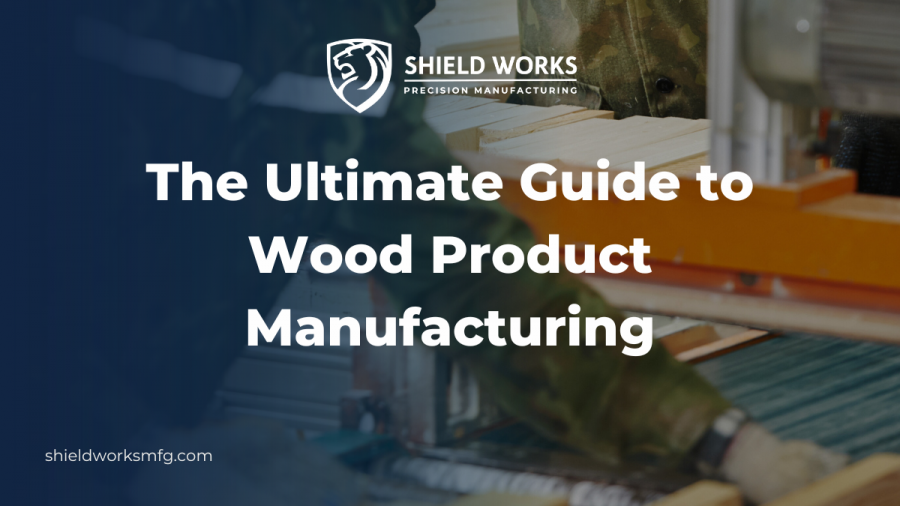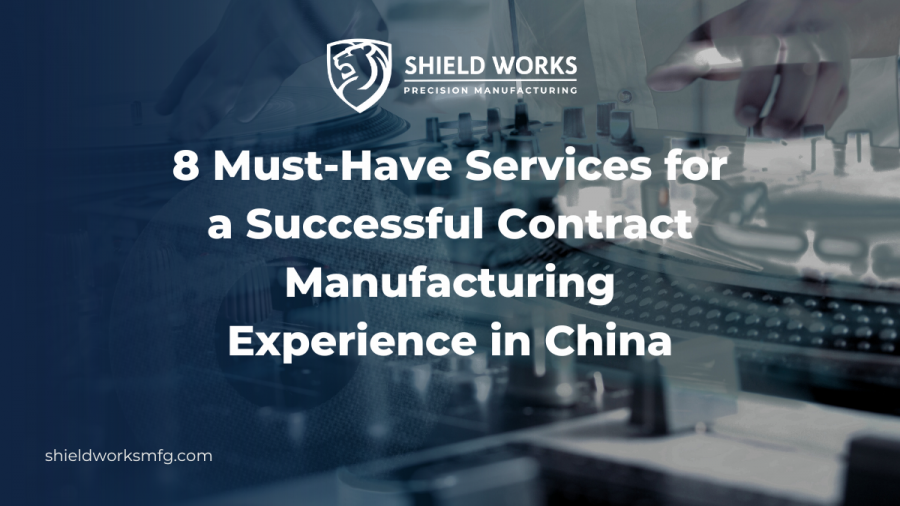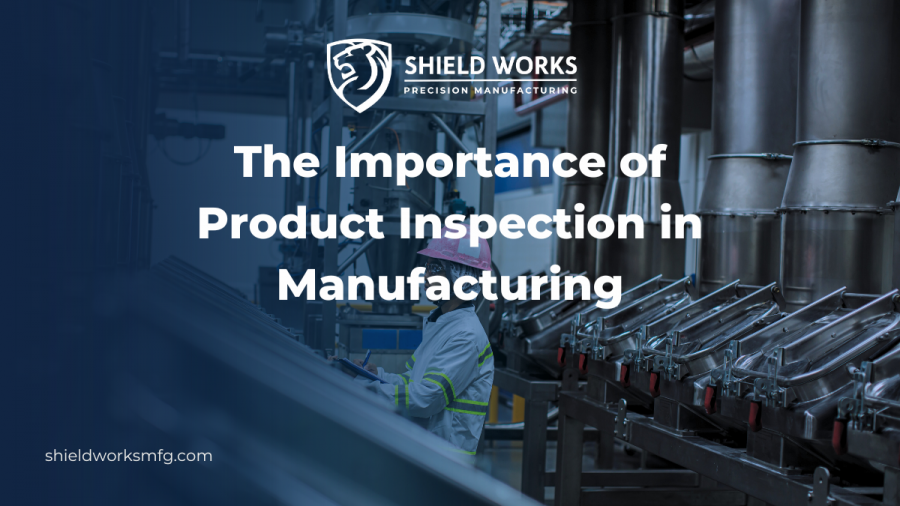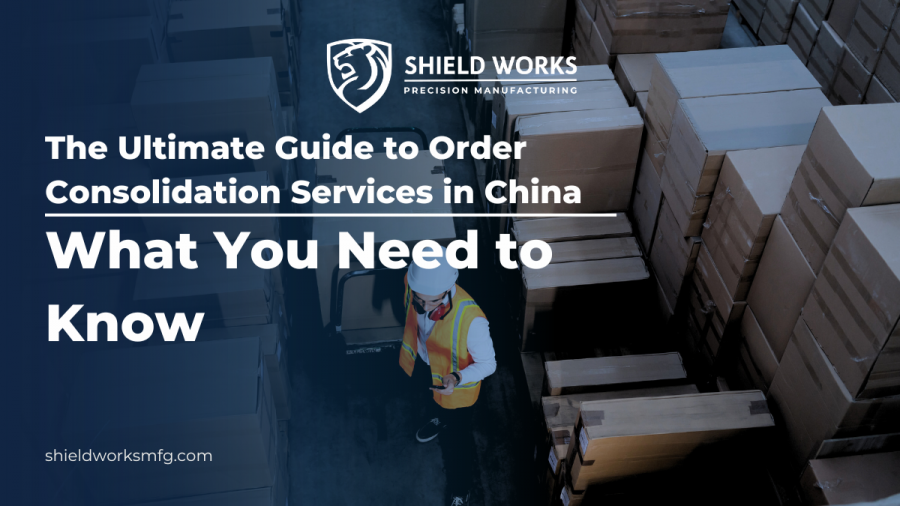Posts by Seline Chen
The Ultimate Guide to Wood Product Manufacturing

In the intricate dance of wood product manufacturing, the line between a seamless operation and logistical chaos is often precariously thin. For businesses threading this needle, the challenge is twofold: crafting premium wood products while safeguarding their designs and operational efficiency.
It’s a high-stakes game of precision, where the smallest miscalculation can fray the tight weave of supply and demand, leaving you with a product that misses the mark. But what if there was a way to smooth out the complexities, to protect your innovations while meeting the exacting demands of the global market?
This guide not only tackles these industry pain points but also presents a blueprint for turning potential pitfalls into your greatest strengths. Keep reading to unearth the strategic advantage that could redefine your position in the wood business.
Working With Wood as a Material
When embarking on wood product manufacturing, the first step is to get acquainted with the material itself. It’s crucial to know that not all wood is the same. Broadly, we categorize wood used in manufacturing into two groups: hardwoods and softwoods.
Hardwoods, like oak and maple, come from deciduous trees that shed their leaves annually. They are typically denser and thus more durable. On the other hand, softwoods, such as pine and cedar, come from coniferous trees and are generally lighter and faster to process.
Each type of wood has a specific role and fits different aspects of the wood business. For example, furniture makers prize hardwoods for their strength and longevity, while softwoods might be the go-to for a construction company looking for framing materials.
Wood Properties
Grain is the next big chapter in the story of wood. The grain refers to the lines that give wood its texture and direction. It’s not just for looks; grain direction can significantly affect how wood behaves when you’re cutting and shaping it. Fine-grained woods are often easier to work with and provide a smoother finish, desirable for high-end wood products.
Density, meanwhile, dictates how heavy and strong the wood is. Denser woods are often more robust, but they can be tougher to work with. On the flip side, less dense woods might be easier to manipulate but can lack the sturdiness needed for certain products.
Then there’s workability, which is all about how well wood responds to tools. Some woods might be a dream to carve intricate designs into, while others are better off for straightforward, functional products.
Sourcing Wood Responsibly
In today’s wood business, sustainability is not just a buzzword; it’s a commitment. Responsible wood product manufacturing means knowing where your material comes from and how it was harvested. It’s about ensuring that for every tree cut down, another is planted, or choosing wood from forests managed sustainably.
Eco-friendly wood sourcing not only supports the planet but also resonates with customers who value sustainability. It’s an approach that requires a bit more effort and understanding, but it pays dividends in the long run by securing the future of both the environment and the wood business.
Design and Prototyping in Wood Product Manufacturing
Design is the cornerstone of creating any wood product. It’s where ideas take shape, blending creativity with practicality.
When you start designing wood products, think about the end user. What will they use it for? How will it improve their lives? The design phase is all about answering these questions while crafting something that’s not only functional but also appealing.
It’s not enough to sketch a concept; you must also consider how it will come together. This is where knowledge of wood properties plays a crucial role. The design must work with the wood’s grain, density, and workability to ensure the final product is both beautiful and durable.
Bringing Ideas to Life
Once the design is on paper, it’s time to move to prototyping. This is the exciting stage where you transform your designs into tangible wood products. Prototyping lets you experiment with the shape, size, and function of your product before full-scale production begins.
During prototyping, you can tweak your design to perfection. Sometimes, what looked good on paper might not hold up in real wood.
Maybe the wood doesn’t carve as easily as anticipated, or the grains don’t align with the design aesthetically. This phase is your chance to make those crucial adjustments.
Testing and Refining
After you’ve made a prototype, test it. Does the drawer open smoothly? Is the chair as comfortable as it is stylish?
This step is vital in the wood business because it’s not just about making wood products; it’s about making wood products that people will love and use.
Testing may lead to more changes, and that’s okay. It’s all part of the process of refinement. Sometimes, you’ll go back to the drawing board several times before getting it right. But each iteration brings you closer to a product that’s sure to stand out in the market.
Cutting-Edge Manufacturing Processes
Today’s manufacturers are combining time-tested skills with advanced technology. Imagine a carpenter’s workshop filled not just with saws and sandpaper but also with computer-controlled machines that cut and shape wood with incredible precision. These Computer Numerical Control (CNC) machines can turn a block of wood into a chair leg or a detailed sculpture, all without a single chisel in sight.
The use of such technology speeds up production times and allows for the creation of more complex designs. It’s a game-changer for manufacturing products out of wood because it means businesses can take on a wider variety of jobs and deliver them with speed and accuracy that hand tools simply can’t match.
While machines have taken on some of the work, there’s still a significant place for the human touch in wood product manufacturing. Skilled craftsmen are essential, especially when it comes to the finer details and finishes that machines can’t replicate. The best wood products come from a mix of automation and artistry, where each plays a role in creating a quality product.
In this field, the craftsman’s expertise enhances the machine’s efficiency, ensuring that every product meets high standards while still retaining the unique character that only hand finishing can provide.
Quality Control and International Standards
Quality control is like the guardian of wood product manufacturing. It’s the set of steps that businesses take to make sure every product is the best it can be. From the first cut of wood to the final polish, quality control is there to catch any mistakes and ensure everything is up to standard.
A big part of maintaining quality is sticking to international standards like those set by the International Organization for Standardization (ISO). These standards provide a framework that helps manufacturers create products that are safe, reliable, and of high quality. They cover everything from the materials used to the processes followed during manufacturing.
The Role of Standards in Manufacturing Quality
For a business manufacturing wood products, adhering to ISO standards is not just about quality; it’s about trust. When customers see that a product meets international standards, they feel confident that it’s going to be good. It’s a sign that a business takes quality seriously and is committed to delivering the best.
These standards are especially important when it comes to exporting products. They assure buyers around the world that the product they’re getting meets the high standards they expect.
Double-Checking with Dual-Layer QC
Some businesses go even further with a dual-layer quality control (QC) approach. This means that once the company’s own QC team has checked the products, a second, independent team takes a look as well.
It’s like having a safety net to catch anything that might have been missed the first time around. For wood products, this could involve checking the strength of a joint, the smoothness of a finish, or the fit of a part in an assembly.
Protecting Intellectual Property Rights
In the world of wood product manufacturing, your ideas and designs are what set you apart. But with these innovations comes the risk of imitation. That’s why protecting intellectual property (IP) rights is as important as the manufacturing process itself.
For businesses in this industry, securing IP means taking legal steps to ensure that nobody else can make or sell your design without your permission. This could involve:
- Patents for new methods of crafting wood
- Copyrights for unique designs
- Trademarks for distinctive brand features
Keeping your innovations protected helps maintain your unique position in the market and ensures that the hard work that went into your designs pays off.
One innovative approach to IP protection is the creation of secure production zones. These are specific areas within a manufacturing facility where sensitive products are made. Access to these zones is limited, and security is tight which means that the risk of leaks or espionage is minimized.
Finalizing the Product
The assembly stage is where all the separate pieces of wood come together to form the final product. This is a critical phase in the manufacturing process because it’s not just about putting parts together; it’s about making sure everything fits perfectly. The assembly process needs to be done with care to ensure that the final product is sturdy and aligns with the design specifications.
After assembly comes the finishing touches. This is where the product gets its final look and feel. Finishing can involve sanding down any rough edges, applying stains or paints, and adding any final details that make the product ready for the customer.
It’s these finishing touches that can transform a well-assembled piece into a beautiful final product that customers will cherish.
The finishing stage is also where OEM manufacturing shines. It allows for customization at the end of the production process to meet specific customer requests. Whether it’s a custom paint job or a special varnish, the ability to customize in the finishing process is essential for meeting diverse customer needs and standing out in the market.
Packaging, Warehousing, and Distribution
When your wood products are ready, they need to be packaged securely to ensure they reach customers without a scratch. Packaging is more than just wrapping up a product. It’s the final step in guaranteeing that the high-quality items you’ve crafted are delivered in top condition.
Smart packaging reflects the quality inside, so it’s important to use materials and techniques that protect the product during transport.
Once packaged, your products enter the warehousing stage. A well-organized warehouse is essential for keeping track of inventory and ensuring that items are easy to find when an order comes in.
Good warehousing practices mean that products are stored safely and efficiently. This reduces the risk of damage and makes the process of shipping orders fast and straightforward.
Distribution is the final leg of the journey. It’s about getting your wood products from the warehouse to the customer. This stage needs to be smooth and reliable, as it’s the point where your product travels through various hands before reaching its final destination.
Efficient distribution involves:
- Selecting the right carriers
- Planning the best routes
- Constantly monitoring the process to ensure timely delivery
In this chain of packaging, warehousing, and distribution, each link must be strong to maintain the integrity and reputation of your wood business. It’s all about creating a seamless flow from the end of the production line to the customer’s door. With careful planning and execution, you can ensure that the quality and craftsmanship of your wood products are evident from the moment they are received.
Your Partner in Precision
Seamlessly blending tradition with technology, wood product manufacturing is not just about what we make but how we make it. This is where Shield Works stands as a beacon of innovation and reliability. With our customized OEM manufacturing solutions and unwavering commitment to protecting your intellectual property, we offer a sanctuary for your most intricate wood products.
We understand that in the wood business, the distinction of your product lies in its details. Let’s discuss how our tailored approach can bring your visionary designs to life. Reach out to Shield Works, and let us craft the excellence that your project deserves.
Key Factors Influencing Efficiency of Electronic Assembly

The electronic assembly stands as the backbone of modern manufacturing, representing the intricate process of seamlessly integrating various components to bring electronic products to life. This pivotal phase not only determines the functionality and reliability of the end product but also significantly shapes its cost-effectiveness and time-to-market.
In this blog post, we embark on a comprehensive exploration of the paramount factors that wield a profound influence on the efficiency of electronic assembly, shedding light on how manufacturers can strategically optimize each element for superior outcomes.
Understanding the Complexities of Electronic Product Assembly
Electronic product assembly is a multifaceted process that involves bringing together various components to create a functional and high-quality end product. The complexity of this task cannot be overstated, considering the diverse range of components, intricate circuitry, and the need for precision in assembly.
From sourcing quality materials to ensuring compliance with industry standards, every step in the assembly process requires meticulous attention. Understanding the intricacies involved is the first step toward achieving excellence in electronic product assembly.
Factors that Directly Impact Efficiency and Quality in Electronic Assembly
The efficiency of electronic assembly processes is influenced by various factors that can impact the overall quality, cost, and speed of production. Here are key factors that play a significant role in determining the efficiency of electronic assembly:
Assembly Precision
The precision with which components are placed and soldered onto the PCB directly impacts the functionality and reliability of electronic products. High precision in assembly is crucial for ensuring that components are correctly aligned and soldered in the right locations. Advanced technologies such as automated optical inspection (AOI) and x-ray inspection systems are employed to verify the precision of component placement and solder joints.
Design for Manufacturability (DFM)
The design of electronic components and circuit boards should consider ease of manufacturing and assembly. Designs that are optimized for the whole process can significantly improve efficiency and quality. This includes considerations such as component placement, ease of soldering, and minimizing the number of complex or delicate components.
Component Selection
Choosing the right components for the application is critical. Components with good availability, reliability, and ease of handling can streamline the assembly process. Standardization of components can also contribute to efficiency by reducing the need for specialized handling and manufacturing processes.
Material Handling and Storage
Proper handling and storage of electronic components before and during assembly are crucial. Components should be stored in conditions that prevent damage from electrostatic discharge (ESD), moisture, and physical mishandling.
Automation and Robotics
Implementing automated assembly processes and robotics can greatly enhance efficiency by reducing manual labor, minimizing errors, and improving precision. Automated systems can handle repetitive tasks quickly and accurately, leading to higher production rates and consistency.
Assembly Line Layout
The physical layout of the assembly line plays a crucial role in efficiency. Optimizing the arrangement of workstations, tools, and equipment can reduce the time it takes to move components from one stage to another. This includes considerations for the flow of materials, minimizing bottlenecks, and optimizing the overall workflow.
Quality Control and Testing
Implementing robust quality control measures and testing procedures ensures that defective components are identified and addressed early in the process. This helps in minimizing rework, reducing waste, and improving overall efficiency.
Soldering and Assembly Techniques
Using appropriate soldering and assembly techniques is crucial for achieving high-quality connections and preventing defects. This includes the use of suitable soldering materials, temperature control, and adherence to industry standards.
Worker Training and Skills
Well-trained and skilled operators contribute significantly to efficiency. Training programs that keep workers up-to-date on the latest assembly techniques, equipment operation, and quality standards can improve overall productivity.
Adherence to Standards and Regulations
Compliance with industry standards and regulations is essential for ensuring the safety, reliability, and performance of electronic products. Adhering to standards also helps in achieving consistency in manufacturing processes.
How to Optimize Electronic Assembly
Now that we’ve identified the critical factors, let’s explore strategies to optimize electronic product assembly:
Invest in Training and Skill Development
Providing ongoing training to assembly line workers ensures that they stay abreast of the latest technologies and assembly techniques. A skilled workforce contributes to higher efficiency and better product quality.
Automated Assembly
Invest in automated assembly processes to increase speed and accuracy. Automated pick-and-place machines, soldering systems, and inspection equipment can significantly improve efficiency.
Utilize Advanced Manufacturing and Assembly Technologies
Embrace Industry 4.0 technologies, such as the Internet of Things (IoT) and real-time data analytics, to create a smart and interconnected assembly line. These technologies offer insights into production processes, enabling proactive decision-making and optimization.
Standardized Processes
Standardize assembly processes to minimize variation and improve repeatability. Clearly document procedures and provide workers with easy access to assembly instructions and guidelines.
Supplier Collaboration
Establish strong partnerships with reliable suppliers. Ensure a steady supply of high-quality components to avoid production delays and defects. If you’re looking for a company in China that can help with your electronic assembly needs, look no further than Shield Works. We follow a rigorous process to ensure quality and consistency from order to delivery. Don’t settle for anything less than perfection – Reach out today to explore how our expertise can elevate your projects.
Outsourcing Precision Assembly to China: A Cost-Effective Solution for Your Business

In today’s competitive market, businesses are always looking for ways to streamline their operations and stay ahead of the curve. One area that is often outsourced is precision assembly, also known as product assembly. And when it comes to outsourcing, China has emerged as a top destination for businesses worldwide. With its skilled labor force, advanced technology, and cost-effective solutions, outsourcing precision assembly to China has become a popular choice for companies looking to improve efficiency and reduce costs. In this blog post, we will explore the many benefits of outsourcing precision assembly to China and why it may be the perfect solution for your business.
Benefits of Outsourcing Precision Assembly to China
Outsourcing precision assembly to China can bring a multitude of benefits to businesses. Firstly, China’s skilled labor force is renowned for its expertise in manufacturing and assembly processes. This means that companies can rely on the high-quality workmanship and attention to detail that Chinese workers bring to the table.
Secondly, China’s advanced technology and infrastructure provide businesses with access to cutting-edge equipment and resources. This allows for efficient and precise assembly processes, ultimately leading to higher quality products.
Additionally, outsourcing precision assembly to China offers cost-effective solutions. The lower labor and overhead expenses in China can significantly reduce production costs for businesses, enabling them to achieve higher profit margins.
Another advantage is the scalability and flexibility that outsourcing to China provides. Businesses can easily adjust their production volumes to meet demand fluctuations without incurring additional costs.
Overall, outsourcing precision assembly to China allows businesses to tap into a skilled labor force, leverage advanced technology, reduce costs, and enhance their competitive advantage. It’s a strategic move that can help businesses streamline operations and achieve long-term success.
Key Considerations when Choosing an Outsourcing Partner in China
When it comes to outsourcing precision assembly to China, there are several key considerations that businesses should keep in mind.
First and foremost, it is essential to thoroughly research potential outsourcing partners and assess their capabilities. Look for companies that have a proven track record in precision assembly and a strong reputation in the industry. This will ensure that you are partnering with a reliable and trustworthy provider.
Another important consideration is communication. Effective communication is crucial for a successful outsourcing partnership. Make sure that the outsourcing partner you choose has excellent communication skills and can understand and meet your specific requirements.
Additionally, consider the location of the outsourcing partner. Look for companies that are strategically located near transportation hubs or have access to reliable logistics networks. This will help to ensure efficient transportation of components and finished products.
Lastly, it is important to consider the cultural differences and language barriers that may exist when outsourcing to China. Look for outsourcing partners that have experience working with international clients and can effectively bridge any cultural or language gaps.
How to Implement Precision Assembly Outsourcing?
Implementing precision assembly outsourcing involves several key steps to ensure a successful and efficient process. Here’s a general guide on how to implement precision assembly outsourcing:
Assess Your Assembly Needs and Cost Structure
Before diving into outsourcing, it’s crucial to conduct a thorough assessment of your assembly needs and current cost structure. Identify the specific components of your products that can be outsourced without compromising quality. Understanding your cost structure will help you determine the potential savings and evaluate the feasibility of outsourcing precision assembly to China.
Research Reliable Chinese Manufacturing Partners
The success of outsourcing depends heavily on selecting the right manufacturing partner. Research and identify reliable Chinese companies with a proven track record in precision assembly. Look for manufacturers that specialize in your industry and have a reputation for delivering high-quality products. Utilize online platforms, industry forums, and recommendations to narrow down your choices.
Consider Language and Cultural Compatibility
Effective communication is key to successful outsourcing. Ensure that the manufacturing partner you choose has staff proficient in your language or is willing to invest in language training. Additionally, understanding the cultural nuances can enhance collaboration and prevent misunderstandings. Choose a partner who values open communication and has experience working with international clients.
Evaluate Quality Control Measures
Maintaining product quality is paramount in any manufacturing process. Evaluate the quality control measures implemented by your potential Chinese partners. Look for certifications, adherence to international standards, and a robust quality control system. Consider visiting the facilities or arranging third-party inspections to ensure that the assembly process meets your standards.
Negotiate Pricing and Contracts
Once you’ve identified a suitable manufacturing partner, engage in transparent negotiations regarding pricing, terms, and contracts. Clearly outline the scope of work, quality standards, delivery schedules, and payment terms. Ensure that the contract includes provisions for dispute resolution and intellectual property protection. Negotiating favorable terms will contribute to the long-term success of your outsourcing arrangement.
Implement Robust Communication Channels
Establishing efficient communication channels is crucial for the success of your outsourcing journey. Leverage digital tools, project management platforms, and regular video conferences to stay connected with your manufacturing partner in China. Effective communication fosters collaboration, ensures alignment with your business goals, and allows for timely issue resolution.
Monitor and Evaluate Performance Continuously
Outsourcing is an ongoing process that requires continuous monitoring and evaluation. Implement performance metrics to track the efficiency and quality of the precision assembly process. Regularly assess key performance indicators (KPIs) and address any issues promptly. This proactive approach will help you make informed decisions to enhance the effectiveness of the outsourcing relationship.
Explore Additional Collaborative Opportunities
As your relationship with your Chinese manufacturing partner develops, explore additional collaborative opportunities. This may include joint research and development projects, shared innovation initiatives, or expanding the scope of outsourcing to include more components of your product. Collaborative partnerships can lead to mutual benefits and contribute to the growth of both businesses.
Unlocking the Potential of Precision Assembly Outsourcing
Outsourcing precision assembly to China is a strategic decision that can bring numerous advantages to your business. By capitalizing on China’s manufacturing capabilities, you can achieve cost savings, tap into a skilled workforce, access advanced technology, and enhance your supply chain efficiency. However, it’s important to approach this endeavor with careful planning and consider the potential challenges. With the right partners and a well-thought-out strategy, outsourcing to China can be a cost-effective and efficient solution for your business, helping you stay competitive in today’s global market. Instead of doing it all on your own, work with Shield Works to make the process easier. Reach out to our engineering team for more information.
OEM vs ODM: Which Manufacturing Model Suits Your Needs Best in China?

China is known as the “world’s factory” for a reason. Its manufacturing prowess is undeniable, and it offers businesses a plethora of options for products. Two of the most popular manufacturing models in China are OEM and ODM. But what exactly do these terms mean, and which one is the best fit for your business? These two models may sound similar, but they actually have distinct differences that can greatly impact your production process. In this blog, we will delve into the differences between OEM and ODM, helping you make an informed decision about which model aligns best with your manufacturing needs.
Understanding the Basics: What is OEM and ODM?
OEM, or Original Equipment Manufacturer, refers to a company that manufactures products based on the design and specifications provided by another company. In other words, they take an existing product and produce it with their own branding. In this model, the manufacturer produces the product exactly as per the specifications provided by the hiring company, known as the brand owner.
On the other hand, ODM, or Original Design Manufacturer, involves a company that not only manufactures products but also designs and develops them from scratch. ODM manufacturers often offer a range of pre-designed products that can be customized to some extent to meet the brand owner’s specific requirements.
While both OEM and ODM involve outsourcing the production to a manufacturer in China, the key difference lies in the level of involvement in the design process. OEM companies focus on production, while ODM companies offer a more comprehensive service by providing design expertise as well. This can be beneficial for companies looking for a manufacturer in China who can help bring their unique product ideas to life.
Deciding Factors: When to Choose OEM or ODM in China?
When it comes to deciding whether to choose OEM or ODM in China, there are several factors to consider.
Product Development Expertise
OEM: If you possess in-house product development expertise, and your product is highly specialized, unique, or proprietary, OEM manufacturing may be the better option. With OEM, you retain full control over the design and specifications of your product, allowing you to bring your innovative ideas to life.
ODM: For businesses with limited product development capabilities or those looking to enter the market quickly with a ready-made product, ODM is a more suitable choice. ODM manufacturers have existing product designs and production processes, which can save you time and resources.
Customization Requirements
OEM: If your product demands a high degree of customization, such as tailored features, branding, or unique specifications, OEM manufacturing is the way to go. You have the freedom to make precise adjustments to meet the specific needs of your target market.
ODM: ODM models, while offering some degree of customization, often have limitations. If your customization needs are relatively minor or can be accommodated within the existing product design, ODM can be cost-effective and efficient.
Intellectual Property Protection
OEM: If you have valuable intellectual property, patents, or proprietary technology, OEM manufacturing is advantageous. You maintain control over your designs, protecting them from potential IP theft or infringement.
ODM: In ODM arrangements, there may be shared intellectual property rights, which could raise concerns about IP protection. If you’re comfortable with shared ownership and can manage IP agreements effectively, this may not be a significant issue.
Time-to-Market Considerations
OEM: OEM manufacturing typically involves longer lead times due to the need to develop and fine-tune product designs, molds, and production processes. If you have time constraints, this may not be the best choice.
ODM: ODM manufacturers have existing designs and production lines, reducing lead times. This makes ODM a favorable option when speed-to-market is a critical factor for your business.
Cost Considerations
OEM: OEM manufacturing often involves a higher initial investment due to the need to develop custom product designs and tooling. If you have the financial resources and are looking for long-term cost savings, this investment can pay off.
ODM: ODM models are generally more cost-effective since the manufacturer has pre-designed products and established production processes. This can result in cost savings and faster ROI, making it suitable for businesses with budget constraints.
Making the Right Choice: Strategic Tips for Choosing Between OEM and ODM
Selecting the right manufacturing model for your business in China is a strategic decision that can significantly impact your success. Both the OEM (Original Equipment Manufacturer) and ODM (Original Design Manufacturer) models have their advantages and trade-offs. To help you make an informed choice, consider these strategic tips when deciding between OEM and ODM:
Understand Your Product and Market
Before deciding between OEM and ODM, thoroughly understand your product and target market. Consider factors such as product complexity, unique features, and the competitive landscape. If your product requires customization and differentiation, OEM might be the better choice. However, if you’re entering a competitive market with standardized products, ODM may offer cost-efficiency.
Evaluate Your In-House Expertise
Assess your company’s capabilities. Do you have a strong in-house product development team capable of creating unique designs? If you have the expertise to develop your product, OEM gives you the freedom to bring your vision to life. If not, ODM’s existing designs can save you time and resources.
IP Protection and Ownership
Consider the importance of intellectual property protection. If you have valuable IP, patents, or proprietary technology, OEM may be the safer option. With ODM, there may be shared IP ownership, which could pose risks.
Cost Considerations
Examine your budget and cost constraints. OEM manufacturing typically involves a higher initial investment due to custom product development. If you have the financial resources and are looking
Product Lifecycle and Long-Term Strategy
Think about your product’s lifecycle and long-term strategy. If your product is unique and you plan to keep it in the market for an extended period, OEM allows you to maintain full control and evolve the product over time. For shorter product lifecycles or when you intend to enter new markets quickly, ODM’s existing designs can be advantageous.
Supply Chain and Quality Control
Evaluate the supply chain and quality control processes of potential manufacturing partners. Both OEM and ODM manufacturers should have robust quality control systems. Ensure that your chosen partner can meet your quality standards and logistical needs.
Negotiate Clear Agreements
When selecting an OEM or ODM partner, negotiate clear agreements regarding intellectual property, quality standards, production timelines, and costs. Protect your interests and ensure that the terms are well-documented in a contract.
Work With a Western-owned Product Assembly Supplier in China
The decision to choose between OEM and ODM manufacturing in China is a pivotal one that requires careful consideration of your product, available resources, and long-term business objectives. This decision is not one to be taken lightly, as it can significantly influence your manufacturing efficiency, product quality, and overall competitiveness in the market.
If you’re looking for a company that can help with your manufacturing project, look no further than Shield Works. At Shield Works, we’re dedicated to not only meeting but surpassing your expectations. Our meticulous attention to detail, combined with advanced quality control measures, guarantees that your vision becomes a reality with unparalleled quality and minimal risks. Take the first step toward realizing your product’s full potential today. Contact us to initiate a conversation about your project, and let’s explore how our expertise can be the driving force behind your success.
The Power of Customized Manufacturing: Boosting Your Business with Tailored Solutions

In the fast-paced world of manufacturing, companies are always on the lookout for ways to stand out and gain a competitive advantage. One approach that has gained immense popularity in recent years is customized manufacturing. By tailoring products and processes to meet the specific needs and preferences of individual clients, businesses can not only differentiate themselves from their competitors but also increase efficiency and customer satisfaction. In this blog, we will explore the power of customized manufacturing and how it can boost your business in today’s ever-evolving market.
Understanding Customized Manufacturing
Customized manufacturing, also known as custom manufacturing or bespoke manufacturing, is a concept that has revolutionized the manufacturing industry in recent years. It involves tailoring products and processes to meet the specific needs and preferences of individual clients, rather than producing a one-size-fits-all solution. This approach allows businesses to stand out from their competitors and provide unique, personalized experiences for their customers.
The Process of Customized Manufacturing
Customized manufacturing allows companies to create products that are unique to each customer’s needs, providing a high degree of flexibility and personalization. Here is an overview of the process of customized manufacturing:
Customer Requirements
The process begins with understanding the customer’s specific requirements and expectations. This involves direct communication and collaboration between the manufacturer and the customer to gather information on product specifications, features, design preferences, quantities, and any other relevant details.
Product Design
Once the customer’s requirements are gathered, the manufacturer’s design team creates a custom design for the product. This design may include CAD (Computer-Aided Design) drawings, prototypes, or other visual representations to ensure that the customer’s vision is realized.
Material Selection
Choosing the appropriate materials is crucial in customized manufacturing. The selection of materials may depend on factors such as product functionality, appearance, durability, and cost. Manufacturers work closely with the customer to select materials that meet their needs and budget.
Manufacturing Process
The manufacturing process is adapted to the specific requirements of the customized product. This may involve various techniques such as machining, 3D printing, welding, casting, or other fabrication methods, depending on the nature of the product. Skilled technicians and engineers oversee the production to ensure it aligns with the customer’s specifications.
Quality Control
Quality control is an essential step in customized manufacturing to ensure that the final product meets the customer’s expectations and industry standards. Inspections and testing are conducted at various stages of production to identify and rectify any defects.
Assembly and Integration
If the customized product is composed of multiple components, they are assembled and integrated to create the final product. This may involve additional quality checks to ensure all components fit and function correctly.
Finishing and Packaging:
The finishing touches, such as painting, surface treatment, or polishing, are applied to enhance the appearance and functionality of the product. Afterward, the product is packaged according to the customer’s preferences, which may include branding, labeling, or custom packaging.
Delivery and Installation:
The customized product is delivered to the customer’s location, and, if necessary, installation and setup services are provided to ensure the product functions as intended.
Advantages of Customized Manufacturing
Tailored Perfection
Customized manufacturing allows for products that are precisely tailored to individual needs and preferences. Whether it’s clothing, electronics, or even food, customers have the ability to create a product that perfectly aligns with their desires. This level of personalization leads to increased customer satisfaction as their unique needs are met.
Customer Satisfaction
When customers are actively involved in the design and creation process, they are more likely to be satisfied with the final product. This, in turn, fosters loyalty. Satisfied customers not only return for future purchases but also become brand advocates, recommending the company to others.
Reduced Inventory and Waste
Since products are made to order, there’s no need for extensive inventory to manage. This means less waste due to unsold or obsolete stock. It’s a more environmentally friendly approach and can lead to cost savings for the business.
Niche Market Opportunities
Businesses can tap into niche markets and cater to specific customer segments by offering unique, customized solutions. This can help them stand out in a competitive market.
Challenges of Customized Manufacturing
Higher Costs
One of the most significant challenges of customized manufacturing is the increased cost. The personalized attention, unique materials, and specialized production processes often result in higher production costs. These costs are often transferred to the customer, making customized products more expensive.
Longer Lead Times
Customized manufacturing typically involves longer lead times compared to mass production. This is because each product is created from scratch, which can result in delays for customers who need their products quickly. This longer lead time can be a drawback in industries where speed is essential, such as consumer electronics.
Complexity in Production
Managing a customized manufacturing process can be complex. It involves coordinating designers, manufacturers, and customers, all of whom have unique needs and expectations. Ensuring that everyone is on the same page and that the product meets the customer’s vision requires careful planning and execution.
Scalability Issues
Scaling up a customized manufacturing business can be challenging. Mass production benefits from economies of scale, which means that costs per unit decrease as production volume increases. Customized manufacturing, on the other hand, doesn’t always benefit from these economies. Meeting increased demand without compromising quality can be a delicate balancing act.
Work With A Customized Manufacturing Company in China
Customized manufacturing is a dynamic and exciting shift in the way products are created and delivered to consumers. It offers the advantage of personalized products that cater to individual preferences while presenting unique challenges like increased costs and longer lead times. As technology continues to advance, the potential for customized manufacturing to become more accessible and scalable increases.
If you’re looking for a company that has all your requirements covered, you need not search any further than Shield Works. With our team’s extensive 18 years of China-based manufacturing experience, Shield Works stands as a trustworthy and professional partner. We specialize in providing customized manufacturing and precision assembly activities exclusively for our Western client base. To ensure the utmost protection of your intellectual property rights, our production zones are dedicated to individual IPR safeguarding within our state-of-the-art Shield Works facility.
At Shield Works, we place paramount importance on delivering solutions that match your unique needs and standards. Our goal is to cater to businesses of all sizes, and we are committed to understanding your specific requirements to provide the best possible service. Reach out today toward a secure and quality-driven manufacturing partnership.
8 Must-Have Services for a Successful Contract Manufacturing Experience in China

China has long been a global manufacturing powerhouse, with its low labor costs, extensive supply chain, and advanced infrastructure making it a go-to destination for contract manufacturing. As companies worldwide seek to optimize their production processes and reduce costs, partnering with a contract manufacturer in China has become increasingly popular. However, to ensure efficiency and success in this endeavor, it’s essential to take advantage of the various services available to streamline production and overcome potential challenges. In this blog, we’ll explore some of these essential services that can help you make the most of your contract manufacturing experience in China.
1. Research and Development (R&D) Support
Today, innovation is paramount for companies striving to maintain a competitive edge. Many contract manufacturers recognize the significance of this, and as a result, they offer comprehensive R&D support services to their clients. These services play a pivotal role in helping businesses explore new materials, cutting-edge technologies, and advanced manufacturing processes. By leveraging such support, companies can embark on a journey to develop products that not only meet but surpass market expectations.
One of the primary advantages of partnering with a contract manufacturer that provides R&D support is the ability to enhance the features of your products. These manufacturers bring a wealth of technical expertise and experience to the table, enabling you to push the boundaries of your product design. By collaborating closely with their R&D teams, you can refine and expand the functionality, aesthetics, and overall appeal of your offerings, ensuring they truly stand out in the market.
2. Design and Engineering Support
Effective contract manufacturing begins with the development of meticulously designed products. In this regard, numerous Chinese manufacturers extend their capabilities by providing comprehensive design and engineering support services. These services are invaluable in assisting you in fine-tuning your product designs to enhance manufacturability, cost-effectiveness, and adherence to regulatory standards. Collaborating closely with seasoned engineers and proficient designers in China affords you the opportunity to tailor your product specifications, thereby minimizing the potential for costly oversights during the manufacturing process.
Chinese manufacturers with design and engineering support services can offer expert insights into making your product designs more manufacturable. They analyze your initial designs and suggest modifications to streamline the manufacturing process. This includes optimizing components, materials, and assembly methods to enhance efficiency and reduce production complexities. The ultimate goal is to make your product easier and more cost-effective to manufacture.
3. Quality Control and Assurance
Ensuring stringent quality control is an indispensable aspect of any manufacturing operation. This principle holds particularly true when working with contract manufacturers, who are acutely aware of the significance of producing top-tier goods that align with global standards. These manufacturers frequently go the extra mile by providing an array of comprehensive quality control and assurance services, thereby upholding their reputation for excellence in product manufacturing.
One fundamental element of quality control is the meticulous inspection of incoming materials. This initial stage is essential to confirm that all raw materials and components meet the specified quality benchmarks. By diligently scrutinizing the materials at the outset, manufacturers can preemptively identify any subpar items and take appropriate corrective measures. Also, a reliable manufacturer may implement rigorous in-process quality checks. These intermediate assessments occur throughout the manufacturing process, ensuring that every step adheres to the defined quality standards.
4. Intellectual Property Protection
When outsourcing your production to China, intellectual property protection is of paramount importance. Ensuring that your valuable innovations, designs, and trade secrets remain secure is essential for the success of your business.
When selecting a contract manufacturer in China, it is imperative that you work with a partner who is willing to negotiate and adhere to comprehensive confidentiality agreements. These agreements should encompass all aspects of your intellectual property, including but not limited to product designs, manufacturing processes, and proprietary technologies.
5. Prototyping and Tooling
Before mass production, it is highly advantageous to initiate the process with the creation of prototypes and the development of custom tooling for your products. Chinese contract manufacturers offer valuable prototyping and tooling services, enabling you to thoroughly assess and improve your product designs. This preliminary phase significantly mitigates the potential for costly revisions further down the production line.
Prototyping serves as a crucial step in the product development cycle. It allows you to transform your conceptual designs into tangible, testable models. By partnering with Chinese contract manufacturers for prototyping, you gain access to their expertise in translating your ideas into physical form. These prototypes are instrumental in evaluating the functionality, aesthetics, and overall viability of your product. Any issues or inefficiencies can be identified and rectified at this early stage, reducing the likelihood of expensive modifications once production is in full swing.
6. Cost Analysis and Reduction
Cost-effectiveness serves as a paramount factor motivating companies to explore the possibility of outsourcing their manufacturing operations to China. The allure of cost reduction is a compelling one, and contract manufacturers in China play a pivotal role in achieving this objective. These entities not only facilitate the offshoring of production but also provide invaluable assistance in conducting thorough cost analyses. Furthermore, they possess the local knowledge and expertise essential for optimizing manufacturing processes, procuring cost-effective raw materials, and minimizing wastage, all of which contribute significantly to the reduction of production costs.
7. Customization and Flexibility
Every business operates with distinct and individualized demands that must be met in order to succeed in their respective markets. Therefore, it is essential to identify and collaborate with a contract manufacturer capable of tailoring their services to meet these specific needs. Whether your business necessitates custom product designs, specialized packaging solutions, or custom labeling requirements, a flexible and adaptable contract manufacturer is your key to achieving success in today’s competitive landscape.
8. On-Time Delivery
The significance of punctual delivery cannot be overstated in today’s fast-paced business environment. Consumer expectations, market trends, and competitive pressures necessitate that companies can swiftly respond to market demands. A contract manufacturer with a consistent record of delivering products on schedule is an invaluable partner in achieving this goal.
When you engage with a contract manufacturer, you’re essentially entrusting a crucial part of your supply chain to them. Their ability to adhere to agreed-upon timelines directly impact their ability to meet consumer demand, seize market opportunities, and maintain a competitive edge.
Work With a Professional Contract Manufacturer in China
Contract manufacturing in China can be a highly efficient and cost-effective option for businesses seeking to optimize their production processes. To ensure success in this venture, taking advantage of the various services provided by Chinese manufacturers is essential.
By choosing the right partner and leveraging these services, you can enjoy the benefits of Chinese contract manufacturing while maintaining the quality and efficiency of your production processes.
When it comes to meeting all your security needs, your search ends here with Shield Works. We take pride in being a British-owned and managed company, specializing in top-tier contract manufacturing and product assembly services that offer both excellence and affordability. Our exceptional emphasis on IP protection ensures your project remains solely yours, safeguarded from inception through to final delivery. Quality isn’t merely a buzzword—it’s ingrained in our process, verified by our ISO 9001, ISO 14001, and ISO 45001 certifications. Our process is rigorous and meticulous, designed to guarantee not only quality but also consistency throughout your experience with us. We understand the importance of delivering on our promises and exceeding your expectations. When you partner with Shield Works, you can be confident that your security and IP concerns are in capable hands. Reach out today to discuss how we can tailor our services to meet your specific needs.
The Importance of Product Inspection in Manufacturing

Chinese-made products are more essential than ever to boost the world economy and meet growing supply chain issues. In August of 2023, China’s industrial production rose by 4.5% year-on-year. This shows a steady and promising increase from the downturn of the previous year.
If you’re partnering with a Chinese manufacturing and assembly company, you need the best quality control services in place. Proper product inspection is a key component of the manufacturing process. It ensures that you receive only the most consistent and quality products.
To learn more about the importance of product inspection in manufacturing, keep reading this informative guide below.
Ensures Quality Assurance
Quality assurance is an important part of the product inspection process in several ways. First, it helps you maintain the utmost product consistency. It also allows your products to meet established quality specifications and industry-specific standards.
Products that meet the requirements of proper product inspection must pass rigorous quality control services. Doing this can protect your business from costly product recalls and customer returns. Quality assurance also gives your products a competitive edge.
Therefore, it’s imperative to implement the most stringent quality assurance policies.
Minimizes the Number of Defective Products
Defective products can damage your business’s profits and your trustworthiness as a brand. If a defective product gets out, it may not work as it should, which can sour a customer’s opinion of your products and ultimately lead to a return and a refund.
Worse than that, however, is that defective products can also lead to injury or death. A defective product then becomes the target of a product recall. Product recalls can warrant the return of an entire lot or product line out of concern for safety.
Meticulous product inspection practices are essential. They can save you from having to go through the expense and effort of product returns and recalls in the long run.
Offers More Cost-Effective Solutions
Good product inspection practices can help you identify and address issues before they happen. Before your products go out into the big wide world, they are evaluated, tested, and examined for any flaws or manufacturing oversights.
It’s easier to catch potential defects in the product design and production process. It’s also more cost-effective since you won’t have to navigate the issues of issuing refunds and paying out settlements for product recalls later on.
Product inspections also save you money you would have to use otherwise to go back to the manufacturing process and rework the flawed product. Instead, you can be sure you’re getting it done right the first time around.
Improves Customer Satisfaction
The satisfaction of your customers is a vital aspect of product inspection. Offering poor-quality products can deter customers from wanting to do business with you. This can hurt your bottom line in a loss of sales.
Having quality product inspection also ensures your products meet or exceed customer expectations. Satisfied customers will also use word-of-mouth and social media promotion to tell their friends and family about your products.
This is even more prevalent with the Gen Z generation. Over 50% of Gen Z’ers would switch from their favorite brands if they found a brand that was cheaper or higher quality. Customers who have a good experience with your products will be more likely to become repeat customers in the future.
Enhances Brand Reputation
Product inspection can also help you improve your brand’s reputation. Offering consistently high-quality products is a surefire way to build brand loyalty.
Customers return to a brand that offers quality products. Even if your brand is more expensive than the competition, 72% of consumers with brand loyalty are willing to pay more for a brand they trust.
You’ll be seen as a brand that cares about its consumers and only offers the highest quality products. This practice, in turn, can reflect positively on your brand.
By actively monitoring the quality of your products through product inspection, you’re helping to protect your brand’s reputation in the process.
Assures Compliance with Manufacturing Standards
Quality standards and regulations in manufacturing and product inspection vary based on the specific industry and the products being manufactured.
Industries often have specific regulations and standards that must be met for items like food, medical devices, and electronics. For example, any products or services in the medical industry need to follow the proper product inspection and quality assurance manufacturing processes.
You will also need to have the appropriate ISO certifications in place for your business. This shows that your products and services have consistently met stringent regulatory requirements.
Reduces Risk Mitigation
Thorough product inspection can save your business from significant backlash in regard to unsatisfactory customer reviews. But it can also aid in the areas of legal compliance and risk mitigation.
In some cases of severe injury or death caused by one of your defective products, you could end up facing legal action. You may also be subject to heavy fines and even experience market entry restrictions as a result. With product inspection protocols in place, you can avoid legal action.
Utilizing product inspection ensures operational continuity as well. It cuts down on the amount of disruptions often caused by product quality issues. So you can keep the manufacturing process running smoothly.
Strengthens Supply Chain Management
Product inspection doesn’t just apply to the finished product. It can also be used to verify that the materials that go into the products themselves are also high quality.
Ensuring that your products are made from quality materials from the start can also reduce the likelihood of product defects and recalls. This helps to increase the overall quality of the products being added to the supply chain. and strengthens it as a whole.
Elevate Your Product Inspection with Shield Works Precision Manufacturing Today
Product inspection is a critical part of the manufacturing process. It ensures product quality and functionality. When it comes to your products, you don’t want to leave anything to chance, especially with overseas production.
Shield Works is a British-owned and managed production assembly company located in the heart of Zhuhai City, China. We offer IPR protective manufacturing and warehouse facilities for all of your overseas product requirements. We’ve been in business since 2005 and have completed over 15,000 products.
Are you ready to get started with your overseas production and manufacturing needs? Then contact Shield Works today for a response within 24 hours.
The Ultimate Guide to Order Consolidation Services in China: What You Need to Know

Are you a business owner looking to streamline your operations and reduce costs in China? Then consolidation services may be the solution you’ve been searching for. In today’s global market, where supply chains are becoming increasingly complex, order consolidation has emerged as a valuable service for businesses operating in China. But what exactly are consolidation services and how can they benefit your company? In this ultimate guide, we’ll dive into the world of consolidation services in China and provide you with everything you need to know to make informed decisions for your business.
What is Order Consolidation?
Order consolidation is a supply chain and logistics process in which multiple individual orders or shipments from different sources are combined or consolidated into a single shipment for delivery to a common destination. This approach can benefit businesses in various ways, such as reducing transportation costs, improving efficiency, and minimizing the environmental impact of shipping.
In the context of China, order consolidation services are particularly useful for businesses that source products from multiple suppliers across the country.
How Does Order Consolidation Work in China?
If you’re a business owner sourcing products from China, order consolidation is a game-changer. It streamlines the process, reduces costs, and enhances efficiency. Here is the process of order Consolidation:
Collecting Goods
When you source products from multiple suppliers in China, each supplier will ship your products to a designated consolidation center. The consolidation center is pivotal in this process, acting as a hub for all your shipments. Every shipment is carefully tracked and logged, ensuring nothing gets lost in transit.
Warehousing
Once your shipments arrive at the consolidation center, they are received and stored. Warehousing is a critical phase as it allows for systematically organizing your products until all your shipments have reached the center. This step ensures that your products are safe and secure while awaiting consolidation.
Quality Control
Quality control is paramount to the success of order consolidation. Before the consolidation process begins, the products are subjected to a thorough inspection. This inspection covers aspects such as quality, quantity, and adherence to your specifications. Any discrepancies are identified and resolved to ensure that you receive the products you expect.
Consolidation
Once all your products have passed the quality control checks at the consolidation center, they are ready for consolidation. This step is where the magic happens. The consolidation center combines all your shipments into a single, cohesive shipment. This consolidated shipment simplifies the logistics process and reduces shipping costs significantly.
Documentation
Order consolidation also eases the burden of handling documentation for customs and shipping. The consolidation center prepares and checks all the necessary documentation for accuracy. This includes customs declarations, packing lists, and any other required paperwork. Having experts handle these crucial documents ensures a smooth customs clearance process and minimizes the risk of delays.
Shipping
The consolidated shipment is then dispatched to your desired destination, which can be an international port or directly to your warehouse.
The Importance and Role of Consolidation Services in Your Business Operations
Consolidation services play a crucial role in the success of your business operations in China. By consolidating orders from different suppliers into one shipment, you can streamline logistics and reduce costs significantly. But the importance goes beyond cost savings. Consolidation services give you greater control over inventory management, providing real-time visibility of goods in transit and reducing lead times. This level of control enhances your overall supply chain efficiency and allows you to better meet customer demands.
Furthermore, consolidation services help you navigate the complexities of the Chinese market. With its vast size, diverse suppliers, and intricate regulations, China can be challenging to navigate. However, by leveraging consolidation services, you can simplify the process and ensure smoother operations. You’ll have a dedicated partner who understands the market and can handle the logistics on your behalf, saving you time and effort. Consolidation services empower your business to stay competitive in a dynamic and rapidly evolving market. So, it’s not just about reducing costs; it’s about gaining a competitive edge and achieving long-term success in China.
Key Considerations When Choosing a Consolidation Service Provider in China
When it comes to choosing a consolidation service provider in China, there are several key considerations you should keep in mind. First and foremost, reliability is of utmost importance. You want to work with a provider that has a proven track record of delivering on time and ensuring the safe arrival of your shipments.
Additionally, it’s crucial to consider the provider’s network and reach. Do they have a wide network of suppliers and warehouses across China? This will ensure that your shipments can be easily consolidated and delivered efficiently.
Another important factor to consider is the provider’s technological capabilities. Do they offer real-time tracking and visibility of your shipments? Can they provide you with detailed reports and analytics? These features will give you better control and transparency over your supply chain.
Lastly, pricing and cost-effectiveness should be taken into account. While cost shouldn’t be the only factor in your decision-making process, it’s important to choose a provider that offers competitive rates without compromising on quality.
The Path Forward with Shield Works
Order consolidation in China is a powerful tool that can transform your sourcing and supply chain operations. It brings together products from different suppliers into a single, efficient shipment, resulting in cost savings, enhanced quality control, and streamlined logistics. By leveraging this process, your business can thrive in the competitive world of international trade.
In a globalized world, the advantages of working with a British-owned and managed contract manufacturer in China are clear. Shield Works Precision Manufacturing, with our order consolidation services and commitment to excellence, stands as an ideal partner for companies seeking efficient and cost-effective solutions.
Our team is driven by innovation, quality, and dedication. By choosing us as your partner in China, you are not just selecting a manufacturer; you are gaining a trusted ally in your quest for business success. Reach out today to learn more about us and how our order consolidation services can benefit your business. With Shield Works, your journey toward efficient and cost-effective manufacturing begins here.
How Can Consolidated Shipping Save Your Business Money?

About 65% of consumers are willing to pay more for faster deliveries.
With any business that sells products, maximizing profitability should always be one of the most important focuses. While selling products is vital here, there are plenty of business operations that will affect the profits that your organization makes.
Shipping is one of the biggest factors, and the larger your business grows, the more important this will be. Consolidated shipping is a solution that can reduce costs, helping to improve your profits.
In this guide, we’ll take a look at the ways in which package consolidation can save your business money. Keep reading for more.
What Is Consolidated Shipping?
Shipment consolidation is a method of shipping goods that involves grouping multiple items together in the same package. This is a common practice with many businesses when it comes to small products. If you were to buy three pairs of socks from a clothing company, for example, you’d expect them to all arrive in the same package rather than three separate ones.
This isn’t seen so much with companies that sell large, heavy, or fragile products. Shipping such items can be more challenging, so most businesses default to packaging them separately.
Benefits of Consolidated Shipping
You may not want to immediately adopt a consolidated shipping approach, but it’s important to consider it as an option. There are several cost-saving benefits that can make it a good move for your business.
Less Expensive Shipments
If you can effectively consolidate shipments, your overall shipping expenses will drop. Every shipment has a cost, but consolidating multiple together into a single shipment will reduce these. You may even be able to share transportation with other shippers, and will then only have to pay for a portion of the costs.
Efficient Resource Utilization
Cargo space and transportation equipment are other costs you need to worry about. Consolidating shipments means that you can make the most out of these resources. More efficient use of space and vehicles means less expenses.
Reduce Carbon Footprint
Consolidating shipments helps to reduce the amount of space needed in transport vehicles. This means you won’t need to use as many trucks (or other shipment methods), leading to reduced fuel consumption.
Not only will this save money on fuel, but it’s also a more environmentally friendly approach. You can highlight this to your customers, as showing that your company is environmentally conscious will help improve your brand image.
Improved Delivery Speed
Consolidated shipping will often mean that your deliveries get to your customers faster. Faster transportation options generally cost more, so being able to save this money while still getting better results is ideal.
Enhanced Security and Reduced Risk
While it’s uncommon, there can be unexpected problems with deliveries at various points on their journey. With consolidated shipping, there are fewer transfers and handling points, which results in less risk of shipments being lost or damaged. Having to replace lost or damaged goods can be costly, so minimizing this issue can be a major benefit.
Streamlined Customs Clearance
If your business sends goods internationally, you’ll need to send them through customs. The customs clearance process can involve a lot of paperwork making shipments take longer. With shipment consolidation, you can streamline this process so you don’t have to spend as much time or money dealing with it.
Improved Customer Service
Quality customer service is vital for any business to succeed. When people order products online, they prefer to know when their goods will arrive, and being able to get shipments to customers faster is always a good thing.
Being able to meet delivery timelines and provide customers with better service will help with customer retention. It always costs less to retain customers than it does to get new ones, so this will help you maintain sales without having to worry so much about lead conversion rates.
Flexibility and Scalability
Having flexibility is always a good thing in business. Shipping consolidation offers adaptable scaling solutions, making it ideal for small and large businesses alike.
This also means it will be easier for you to scale your shipping needs as your business grows. Growth is always good, but it often presents challenges that many businesses aren’t prepared for. Being able to maintain efficient shipment practices and consistency will prevent issues that could end up costing your business a lot of money.
Collaboration and Networking
Shipment consolidation encourages collaboration between carriers, shippers, and logistics providers. This helps to foster networks and create opportunities for all those involved. Different businesses can then share resources and ideas to further benefit both of them.
Economies of Scale
As your business grows and sales increase, your cost per sale will go down. This is known as economies of scale, and consolidating shipments can help build this.
On top of saving on costs from each sale, your negotiation power with carriers will increase. You may then be able to get better rates and handling fees, as well as other potential cost advantages.
Scenarios Where Consolidated Shipping Is the Right Choice
Consolidated shipping may sound a bit complex. To get a better idea of when it would be most, consider these examples.
Firstly, if you often sell certain items together, you may benefit from consolidating them. For example, if you sell sporting goods, you might often sell skis along with items like helmets, goggles, gloves, etc. You could even offer them together as a package deal in your online store to encourage sales.
Another good example is if you have small items that could easily go into a larger box along with a large item. These small items might not need their own boxes, so you can save by packaging them with bigger items.
Just bear in mind that it’s not always the best option. Consider the potential drawbacks so you know what choice to make.
Improved Shipping and Logistics
Consolidated shipping can help you save money in a range of ways. It’s worth taking the time to refocus your logistics approach to reduce company shipping costs and make it easier for your business to grow.
Shield Works offers warehousing and 3PL services that can help you reach your business goals. Contact us today to find out more about how we can help your business.
The Importance of Accuracy: A Closer Look at Precision Assembly

Precision assembly is a crucial aspect of manufacturing that plays a significant role in producing high-quality products. It involves the meticulous and accurate construction of complex components and products, making it an essential step in many industries. For companies seeking precision assembly services, there are various options available, including precision assembly in China. However, with so many providers to choose from, it’s crucial to understand the importance of accuracy and carefully consider several factors when selecting a precision assembly service provider. In this blog post, we’ll take a closer look at precision assembly and why it is crucial for businesses looking to achieve exceptional quality in their products.
Understanding Precision Assembly and Its Role
Precision assembly is a complex process that involves the meticulous construction of intricate components and products. It is a crucial step in manufacturing, as it ensures the final product meets high-quality standards.
Precision assembly plays a significant role in various industries, including automotive, aerospace, electronics, and medical. In the automotive industry, for example, precision assembly is essential for ensuring the seamless integration of various components, such as engines, transmissions, and electrical systems. In the aerospace industry, precision assembly is critical for building aircraft that are safe and reliable.
The role of precision assembly extends beyond simply putting parts together. It requires careful attention to detail, precision measurements, and the use of specialized tools and equipment. Precision assembly also involves adherence to strict quality control standards and ensuring that each component is properly aligned and connected.
Key Factors to Consider When Selecting a Precision Assembly Service
When selecting a precision assembly service for your project, there are several key factors to consider to ensure that you make the right choice. Here are some key factors to keep in mind:
Expertise and Experience:
Look for a service provider with a strong history in precision assembly. Consider how long they have been in operation and their experience with similar projects. An experienced provider is more likely to have refined their processes and developed the necessary skills for precision work.
Technology and Equipment:
Investigate the provider’s equipment and technology. Precision assembly often requires advanced machinery such as CNC machining centers, 3D printers, laser cutters, and more. Ensure they have the necessary tools to handle your project’s unique demands.
Skilled Workforce:
The qualifications and expertise of the assembly team are paramount. Highly skilled engineers, technicians, and assemblers with a deep understanding of precision techniques and craftsmanship are essential to achieving high-quality results. Assess the qualifications and experience of the team. Engineers, technicians, and assemblers should have the necessary training and expertise in precision assembly techniques, including familiarity with CAD/CAM software.
Tolerance Levels:
Precision assembly often involves working with very tight tolerances. Clearly define your required tolerance levels and ensure the provider can consistently meet these specifications without compromising quality.
Quality Control and Certifications:
Ensure the service provider maintains rigorous quality control standards. Industry certifications, such as ISO 9001, AS9100 (for aerospace), or ISO 13485 (for medical devices), demonstrate their commitment to meeting and exceeding quality requirements.
Prototyping and Testing:
Verify if the service offers prototyping and testing capabilities. This is crucial for validating your design and ensuring it performs as expected before moving to full-scale production. It allows for adjustments and improvements to be made early in the process.
Scalability:
Consider whether the provider can scale their services to accommodate changes in production requirements. If your project volume fluctuates, flexibility and scalability are crucial to meeting your needs efficiently.
The Impact of Accuracy in Precision Assembly
The impact of accuracy in precision assembly cannot be overstated. Every component, every connection, and every measurement must be meticulously executed to ensure the final product meets the highest quality standards. The slightest deviation from accuracy can have far-reaching consequences, leading to product malfunctions, safety risks, and costly rework or recalls.
When precision assembly is done with utmost accuracy, the benefits are substantial. The final product operates seamlessly, performs at optimal levels, and surpasses customer expectations. Precision assembly ensures that all components fit together precisely, resulting in improved functionality and longevity.
Furthermore, accuracy in precision assembly leads to enhanced efficiency and productivity. When parts fit perfectly, there is no wasted time or effort spent on adjusting or reworking components. This streamlines the manufacturing process, allowing for faster production cycles and increased output.
Accuracy also plays a significant role in cost savings. By eliminating errors and rework, precision assembly reduces waste, lowers production costs, and minimizes the risk of expensive product recalls. In industries like aerospace and medical, where safety and reliability are paramount, accuracy is crucial to prevent catastrophic failures.
Work With a Western-owned Product Assembly Supplier in China
Remember that precision assembly is not just about putting together parts; it’s about crafting works of engineering excellence that adhere to tight tolerances, meet strict industry regulations, and deliver on the promise of quality and reliability.
Therefore, when embarking on your quest to find the ideal precision assembly service, it’s crucial to select a professional assembler in China that not only meets your technical requirements but also instills trust and facilitates seamless communication throughout the entire process.
If you’re seeking a precision assembly service that combines the best of both worlds – the precision expertise of China with the quality assurance and communication standards of the West – look no further than Shield Works. We are a British-owned product assembly supplier in China to benefit from the synergy of both Eastern craftsmanship and Western accountability.
We offer a unique blend of technical excellence, industry certifications, and a Western management approach, ensuring that your precision assembly project is in safe hands. Our skilled team, cutting-edge technology, and commitment to quality make us the ideal partner for your custom assembly needs. Reach out to us today and experience the excellence of precision assembly with a global touch.


